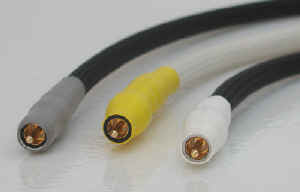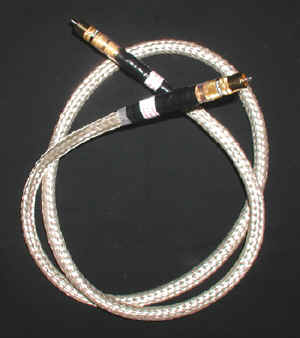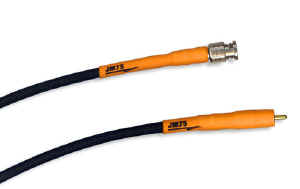You are reading the older HTML site
Positive Feedback
ISSUE
3
october/november 2002
Digital Cable Round-Up
by A.D. Banerjee
Dave Clark is the only audioMUSINGS staff member that uses a transport and DAC (or was—he’s now shifted to a single-box player—the Cary 306/200), so despite the fact that I am not in the habit of writing audio reviews, he asked me to listen to some digital cables and report my findings. I use a Dodson DA-217 MkII D-to-A converter in a second system, with a modified Pioneer player as transport. I normally use a Jena Labs digital cable that is a few years old—I’ve tried others, but always go back to the Jena. The speakers are Quad ESLs. As their many devoted fans are aware, these speakers are extremely transparent, and very revealing of system problems, including digital harshness and grain.
I have no idea why one digital cable should sound better, or even different, than another. With interconnects and speaker cables, sonic differences are not hard to grasp. First, these cables convey analog signals, and second, their fundamental electrical characteristics are well understood. If two speaker cables differ in, say, capacitance, it will affect the interaction between the amplifier and speakers, and thus affect the sound. There are other factors to be considered, among them the materials used to make the wire, the configuration of the wire strands, the dielectric material, and so on. With digital cables, none of this should matter. They simply need to transmit digital information, which should mean that they either work properly or they don’t. Early in the digital era, research indicated that the impedance of both the wire and the connectors were important in digital cable, but none of the other factors that affect analog signals should make any difference. Nevertheless, different digital cables give different sonic results. I’d love to know why, but can accept the fact that it happens and move on.

Dynamic Designs from left to right; Platinum Reference, THB,
and the White Line
The information sheets provided by Dynamic Design—three of whose cables are part of this survey—only hint at why they believe their company’s cables stand out from the pack. While Dynamic Design’s goal is said to be faithful signal transmission, achieved by using "the highest quality materials" and "innovative design processes," few details are given. Regarding insulation, it is said that "the very best air impregnated insulators are used," though the material is not mentioned, nor is it stated how that material is "air impregnated." The wire material is trademarked, so naturally it, too, is not mentioned, except to say that it is "high purity bi-metal." The shielding? Also proprietary, so nothing is said except that a "unitized shielding array"—whatever that may be—is employed. About the jackets, a relative barrage of facts is given, though hardly more information. The jackets, they say, "simulate the properties of a wave-guide or semi-rigid interconnect system." These jackets apparently allow only a "very limited bend radius," and this helps maintain "uniform electrical characteristics across the length of the cable."
I can’t comment about uniform electrical characteristics, but can report that as the Dynamic Design cables increase in price, they also increase in stiffness, to an almost ludicrous degree. The least expensive of the three, the Whiteline ($600 per meter), is stiff, though not excessively so, while the next, the Platinum Reference ($900 per meter), is much more inflexible. The most expensive of the three, the THB ($1500 per meter), is so springy that I had difficulty installing it in the limited space behind my rack, and then discovered that it had nearly flung my transport out the front.
The Dodson DAC has input switches on the front panel, so it was possible to make rapid comparisons between the Jena and the Dynamic Design cables. To keep the comparisons manageable, I used only two pieces of music, one simple, one complex—the first a folk piece featuring only guitar and female voice, the second a large-scale orchestral work. I began with the folk piece, using my normal setup. As expected, the sound was full and detailed, and the reverberance of the voice and guitar made it possible to clearly discern the size of the recording space. Upon switching to the Whiteline cable, the sound became slightly cooler, with an accompanying reduction of the fullness of both the voice and the guitar. Though I prefer a full-bodied sound, the effect was not dramatic, and I did not find it terribly troublesome, but a noticeable reduction in soundstage depth bothered me much more. The reverberance was still evident, but was now merely one set of artifacts among many, and no longer gave the sense that the two performers were standing together in a room. The results with the orchestral piece were much the same. Instead of fleshed-out images in a clearly defined space, I heard shallow ones pasted onto the front of the soundstage. With so large a group of performers, this was quite disconcerting.
The Platinum Reference was a considerable improvement. The sound was still a bit cooler than with the Jena cable, but the soundstage was now very nearly as deep. Though I still preferred the marginally fuller sound of the system with the Jena in place, the sonic differences were now so slight that I could live comfortably with either. Listeners with different sonic preferences (and/or different systems) could easily go the other way. The THB parsed these differences even finer. My test recordings now sounded nearly as warm as with the Jena cable, and the differences in soundstage depth were negligible. Given the springiness of the THB cable, I don’t think I’d want to use it, even if I preferred it. I still preferred the Jena, so the point is moot, but the issue for listeners who prefer a cooler sound should be whether the differences between the THB and the Platinum Reference are worth the THB’s considerable increase in cost. Unless your system is capable of extremely high resolution, I doubt it.

Marigo Apparition
The Marigo Apparition ($595 per meter) has an outer jacket made of woven metal mesh, and is by far the stiffest cable of the bunch. However, unlike the THB, which is both stiff and springy, the Apparition is so rigid that it stays in whatever position you choose, and this makes it easy to work with. As for the sound, it was far warmer than any of the Dynamic Design cables, warmer even than the Jena, though with no apparent loss of air or detail. The soundstage was deeper and wider than that of any of the other cables used in this survey, though the Jena came in a close second in this regard. This was especially apparent with the orchestral piece, and I appreciated both the Apparition’s warmth and its soundstaging capabilities with this music. I was a bit ambivalent about these qualities with respect to the folk piece, though, finding that I had lost a bit of the immediacy that I get with the Jena cable in place.

JM75
All of these digital cables are fairly pricey, and I would recommend careful listening in your system before making a financial commitment to any of them. The remaining cable, the JM75, is so inexpensive ($100 per meter) that I can recommend it without hesitation to anyone on a budget, with the caveat that the inexpensive system this is likely to go into falls on the bright/hard rather than the warm/soft end of the audio spectrum. While warmer even than the Marigo Apparition, the JM75 fell short with respect to air and detail. I enjoyed my listening time with it despite these faults, though it should be apparent by now that those faults complement rather than contradict my listening preferences.
Marigo Audio Lab
web address: www.marigoaudio.com
e-mail address: [email protected]
JM75
web address: www.photojm.com/jm75
e-mail address: [email protected]
Dynamic Designs
e-mail address: [email protected]
